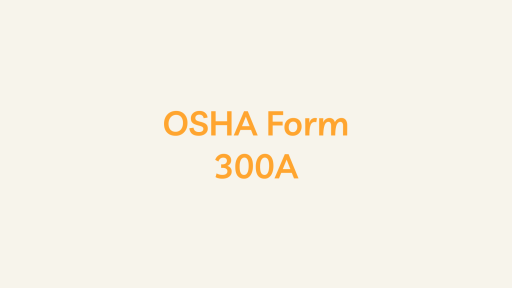OSHA Form 301, officially titled “Injury and Illness Incident Report,” is a document used in the United States as part of the Occupational Safety and Health Administration’s (OSHA) recordkeeping and reporting system. This form is designed to provide a more detailed account of a specific work-related injury or illness, supplementing the information recorded on OSHA Form 300.
Here are key details about OSHA Form 301:
Purpose and Usage:
- Detailed Incident Reporting:
- OSHA Form 301 is used to gather more comprehensive details about a specific workplace incident, beyond the summary information captured on OSHA Form 300.
- Supplement to Form 300:
- While OSHA Form 300 provides an overview of work-related injuries and illnesses, Form 301 is used for individual incidents, offering a deeper understanding of each case’s circumstances.
Components of OSHA Form 301:
1. Employee Information:
- Captures details about the injured or ill employee, including name, job title, and department.
2. Incident Details:
- Provides a narrative description of the incident, including how it occurred and the factors involved.
3. Injury or Illness Details:
- Specifies the nature of the injury or illness, the part of the body affected, and any objects or substances involved.
4. Medical Treatment:
- Records the type of medical treatment received, including first aid, prescription medications, or hospitalization.
5. Days Away from Work:
- Indicates the number of days the employee is expected to be away from work due to the incident.
6. Job Transfer or Restriction:
- Documents any job transfers or work restrictions resulting from the incident.
7. Employer’s Report:
- Allows the employer to provide additional information and details related to the incident.
Completing and Retaining OSHA Form 301
- Prompt Completion:
- Employers must complete OSHA Form 301 within seven calendar days of receiving information about a recordable injury or illness.
- Confidentiality:
- Employers must ensure the confidentiality of the information recorded on Form 301, respecting the privacy of the affected employee.
- Retention:
- OSHA Form 301 is to be retained by the employer for the duration of the employee’s employment and five years after separation.
Relationship with Other OSHA Forms
- OSHA Form 300:
- While OSHA Form 300 provides an overview and summary of work-related injuries and illnesses, Form 301 offers a detailed incident-specific report.
- OSHA Form 300A:
- Form 301 complements the information on Form 300A, which is the Summary of Work-Related Injuries and Illnesses, often posted in the workplace.
Importance in Recordkeeping
- In-Depth Analysis:
- OSHA Form 301 facilitates more in-depth analysis of individual incidents, helping employers identify root causes and implement preventive measures.
- Compliance and Documentation:
- Completing OSHA Form 301 is essential for OSHA compliance and maintaining accurate documentation of work-related incidents.
Conclusion
OSHA Form 301 is crucial in providing a detailed account of specific work-related injuries and illnesses, contributing to a comprehensive recordkeeping system that promotes workplace safety and regulatory compliance. Employers must ensure this form’s accurate and timely completion to meet OSHA requirements.





